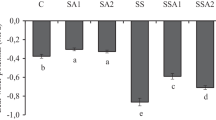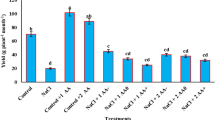Abstract
The possible role of salicylic acid (SA) and methyl jasmonate (MJ) treatments on the physiology responses and growth of strawberry (Fragaria × ananassa) cv. ‘Camarosa’ subjected to the different levels of salinity stress were investigated. Root and shoot growth as well as their Na+/K+ ratio, photosynthetic-related factors, and activity of some important antioxidant enzymes were determined in the salt-treated plants. Results indicated that salt stress reduced plant performance especially at higher concentrations. By increasing the levels of salinity stress, fresh and dry weight of shoot and roots, net photosynthetic rate (Pn), and stomatal conductance (Gs) significantly decreased, whereas intercellular CO2 (Ci) increased. Application of exogenous SA and MJ significantly improved the plant physiological characters as well as fresh and dry weight of shoots and roots. Moreover, the ratio of Na+/K+ was elevated in the leaves and roots concomitantly with salinity levels, whereas SA and MJ treatments significantly reduced this ratio. Results of enzymatic assays showed that activity of ascorbate peroxidase, peroxidase, and superoxide dismutase enzymes increased in the salt-stressed plants. In addition, SA and MJ treatments reduced the destructive effects of salinity in strawberry plant. In general, among the tested concentrations, 0.5 mM SA and 0.25 mM MJ best increased the activity of antioxidant enzymes and hence alleviated the detrimental effects of salinity stress.
Similar content being viewed by others
References
Abu-Ghalia H, El-Khalal S (2001) Interaction between mycorrhizal fungi and Jasmonic acid and their effects upon the growth, and metabolic activities of lupine plants grown under saline conditions. Egypt J Bot 41:201–206
Aftab T, Khan MMA, Idrees M, Naeem M, Moinuddin (2010) Salicylic acid acts as potent enhancer of growth, photosynthesis and artemisinin production in Artemisia annua L. J Crop Sci Biotech 13:183–188
Al-Hakimi AMA, Hamada AM (2001) Counteraction of salinity stress on wheat plants by grain soaking in ascorbic acid, thiamin or sodium salicylate. Biol Plant 44:253–261
Alian A, Altman A, Heuer B (2000) Genotypic difference in salinity and water stress tolerance of fresh market tomato cultivars. Plant Sci Hort 152:59–65
Analytical Software (2005) Statistix version 8.1: User’s manual. Analytical Software, Tallahassee
Anonymous (2013) Agriculture Statistic, Volume III, Horticultural Crops, Iran’s Ministry of agriculture
Asada K (1999) The water-water cycle in chloroplasts: scavenging of active oxygens and dissipation of excess photons. Ann Rev Plant Physiol Plant Mol Biol 50:601–639
Behnamian M, Masiha S (2006) Strawberry, 2nd edn. Sotodeh publication, Tanriz, p 120
Brugnoli E, Lauteri M (1991) Effects of salinity on stomatal conductance, photosynthetic capacity and carbon isotope discrimination of salt–tolerance (Gossypium hirsutum L.) and salt– sensitive (Phaseolus vulgaris L.) C3 non–halophytes. Plant Physiol 95:628–635
Burgos PA, Roldan I, Donaire JP (1993) Effect of sodium chloride on growth, ion content, and hydrogen ion extrusion activity of sunflower and jojoba roots. Plant Nutr 16:1047–1058
Cherki G, Ahmed F, Khalid F (2002) Effects of salt stress on growth, inorganic ions and proline accumulation in relation to osmotic adjustment in five sugar beet cultivars. Environ Exp Bot 47:39–50
Choudhury S, Panda SK (2004) Role of salicylic acid in regulating cadmium induced oxidative stress in Oryza Sativa L. roots. Bulg J Plant Physiol 30(3–4):95–110
Comparot SM, Graham CM, Reid DM (2002) Methyl jasmonate elicits a differential antioxidant response in light and dark grown canola (Brassica napus) roots and shoots. Plant Growth Regul 38:21–30
Dar TA, Uddin M, Khan MMA, Hakeem KR, Jaleel H (2015) Jasmonates counter plant stress: a review. Environ Exp Bot 115:49–57. doi:10.1016/j.envexpbot.2015.02.010
Ding H, Lai J, Wu Q, Zhang S, Chen L, Dai YS, Wang C, Du J, Xiao S, Yang C (2015) Jasmonate complements the function of Arabidopsis lipoxygenase3 in salinity stress response. Plant Sci. doi: 10.1016/j.plantsci.2015.11.009
EI-Tayeb MA (2005) Response of barley gains to the interactive effect of salinity and salicylic acid. Plant Growth Regul 45:215–225
Eraslan F, Inal A, Gunes A, Alpaslan M (2007) Impact of exogenous salicylic acid on the growth, antioxidant activity and physiology of carrot plants subjected to combined salinity and boron toxicity. Sci Hort 113:120–128
FAO (2005) Global network on integrated soil management for sustainable use of salt-affected soils. FAO Land and Plant Nutrition Management Service, Rome. http://www.fao.org/ag/agl/agll/spush
Giannopolitis CN, Ries SK (1977) Superoxide dismutase: occurrence in higher plants. Plant Physiol 59:309–314
Greenway H, Munns R (1980) Mechanisms of salt tolerance in non-halophytes. Annu Rev Plant Physiol 31:149–190
Gunes A (2007) Salicylic acid induced changes on some physiological parameters symptomatic for oxidative stress and mineral nutrition in maiz (Zea mays L.) grown under salinity. Plant physiol 164:728–736
Gupta B, Huang B (2014) Mechanism of salinity tolerance in plants: physiological, biochemical, and molecular characterization. Int J Genomics ID 701596:18. doi: 10.1155/2014/701596
Jayakannan M, Bose J, Babourina O, Rengel Z, Shabala S (2013) Salicylic acid improves salinity tolerance in Arabidopsis by restoring membrane potential and preventing salt-induced K + loss via a GORK channel. J Exp Bot 64:2255–2268. doi:10.1093/jxb/ert085
Jung S (2004) Effect of chlorophyll reduction in Arabidopsis thaliana by methyl jasmonate or norflurazon on antioxidant systems. Plant Physiol Biochem 42:231–255
Kang DJ, Seo YJ, Lee JD, Ishii R, Kim KU, Shin DH, Park SK, Jang SW Lee IJ (2005) Jasmonic acid differentially affects growth, ion uptake and abscisic acid concentration in salt-tolerant and salt-sesitive rice cultivars. J Agron Crop Sci 191(4):273–282
Keutgen AJ, Pawelzik E (2009) Impacts of NaCl stress on plant growth and mineral nutrient assimilation in two cultivars of strawberry. Environ Exp Bot 65:170–176
Khan W, Prithiviraj B, Donald SL (2003) Photosynthetic responses of corn and soybean to foliar application of salicylates. Plant Physiol 160:485–492
Konan, YKF, Kouassi, KM, Kouakou KL, Koffi E, Kouassi KN, Sekou D, Kone M, Kouakou TH, (2014) Effect of methyl jasmonate on phytoalexins biosynthesis and induced disease resistance to Fusarium oxysporum f. sp. Vasinfectum in cotton (Gossypium hirsutum L.). Int J Agronomy 2014 ID:806439, p 11, doi: 10.1155/2014/806439
Lee S, Kim SG, Park CM (2010) Salicylic acid promotes seed germination under high salinity by modulating antioxidant activity in Arabidopsis. New Phytol 188:626–637. doi:10.1111/j.1469-8137.2010.03378.x
Maggio A, Raimondi G, Martino A, Pascale SD (2007) Salt stress response in tomato beyond the salinity tolerance threshold. Environ Exp Bot 59:276–282
Maslenkova L, Zanev Y, Popova LP (1993) Adaptation to salinity as monitored by PSII oxygen evolving reactions in barley thylakoids. Plant Physiol 142:629–643
Munné-Bosch S, Allegre L (2002) Plant aging increases oxidative stress in chloroplasts. Planta 214:608–615
Mustafa Z, Pervez MA, Ayyub CM, Matloob A, Khaliq A, Hussain S, Ihsan MZ, Butt M (2014) Morpho-physiological characterization of chilli genotypes under NaCl salinity. Soil Environ 33:133–141
Nakano Y, Asada K (1981) Hydrogen peroxide is scavenged by ascorbat peroxidase in spinach chloroplasts. Plant Cell Physiol 22:867–880
Norastehnia A, Nojavan-Asghari M (2006) Effect of methyl jasmonate on the enzymatic antioxidant defense system in maize seedling subjected to paraquat. Asian J Plant Sci 5(1):17–23
Qadir M, Qureshi AS, Cheraghi SAM (2008) Extent and charateristion of salt-affected soils in Iran and strategies for their amelioration and management. Land Degrad Dev 19:214–227
Rady MM, Bhavya Varma C, Howladar SM (2013) Common bean (Phaseolus vulgaris L.) seedlings overcome NaCl stress as a result of presoaking in Moringa oleifera leaf extract. Sci Horti 162: 63–70
Rahat N, Iqbal N, Nafees SS, Khan A (2011) Salicylic acid alleviates decreases in photosynthesis under salt stress by enhancing nitrogen and sulfur assimilation and antioxidant metabolism differentially in two mungbean cultivars. Plant Physiol 168:807–815
Reona A, Ito AN, Nakayamaa N, Suwaa R, Nguyena NT, MJuan ÁL, Esakab M, Fujiyamac H, Saneokaa H (2010) Fruits are more sensitive to salinity than leaves and stems in pepper plants (Capsicum annuum L.). Rev Sci Hort 125:171–178
Richards IR, Clayton CJ, Reeve AJK (1998) Effects of longterm fertilizer phosphorus application on soil and crop phosphorus and cadmium contents. Agric Sci 131:187–195
Rout NP, Shaw BP (2001) Salt tolerance in aquatic macrophytes: possible involvement of the antioxidative enzymes. Plant Sci 160:415–423
Saied AS, Kentgen N, Noga G (2003) Effects of NaCl stress on leaf growth, photosynthesis and ionic contents of strawberry cultivars ‘Elsanta’ and ‘Korona’. Acta Hort 609:67–73
Salimi F, Shekari F, Hamzei J (2016) Methyl jasmonate improves salinity resistance in German chamomile (Matricaria chamomilla L.) by increasing activity of antioxidant enzymes. Acta Physiol Plant 38:1. doi:10.1007/s11738-015-2023-4
Samia ME, Tahani AH, Raheim AE, Kerrit AAA (2009) Brassinolide and salicylic acid induced antioxidant enzymes, hormonal balance and protein profile of maize plants grown under salt stress. Res J Agric Biol Sci 5(4):391–402
Shabina S, Anjum NA, Nazar R, Iqbal N, Masood A, Khan NA (2011) Salicylic acid-mediated changes in photosynthesis, nutrients content and antioxidant metabolism in two mustard (Brassica juncea L.) cultivars differing in salt tolerance. Acta Physiol Plant 33:877–886
Shekarchian A, Etemad V, Bihamta MR, Assareh MH (2016) Effects of salicylic acid on physiological traits of myrtle seedlings in salt stress condition. AES Bioflux 8(1):14–23
Sheteawa SS (2007) Improving growth and yield of salt-stressed soybean by exogenous application of jasmonic acid and ascobin. Int J Agri Biol 9(3):473–478
Shi J, Ma CY, Qi DD, Lv HP, Yang T, Peng QH, Chen ZM, Lin Z (2015) Transcriptional responses and flavor volatiles biosynthesis in methyl jasmonate-treated tea leaves. BMC Plant Biol 15:233. doi:10.1186/s12870-015-0609-z
Soares AMS, De Souza TF, Jacinto T, Machado OT (2010) Effect of methyl jasmonate on antioxidative enzyme activities and on the contents of ROS and H2O2 in Ricinus communis leaves. Braz J Plant Physiol 22(3):151–158
Stevens J, Senaratna T, Sivasithamparam K (2006) Salicylic acid induces salinity tolerance in tomato (Lycopersicon esculentum cv. Roma): associated changes in gas exchange, water relations and membrane stabilisation. Plant Growth Regul 49:77–83
Sun G, Yang Y, Xie F, Wen J-F, Wu J, Wilson IW, Tang Q, Liu H, Qiu D (2013) Deep sequencing reveals transcriptome re-programming of taxus6media cells to the elicitation with methyl jasmonate. PLoS ONE 8(4):e62865. doi:10.1371/journal.pone.0062865
Sun Y, Niu G, Wallace R, Masabni J, Gu M (2015) Relative salt tolerance of seven strawberry cultivars. Horticulturae 1(1):27–43. doi:10.3390/horticulturae1010027
Urbanek H, Kuzniak-Gebarowska E, Herka K (1991) Elicitation of defense responses in bean leaves by Botrytis cinerea polygalacturonase. Acta Physiol Plant 13:43–50
Vaidyanathan H, Sivakumar P, Chakrabatry R, Thomas G (2003) Scavenging of reactive oxygen species in NaCl-stressed rice (Oryza sativa L.) differential response in salt-tolerant and sensitive varieties. Plant Sci 165:1411–1418
Wang SY, Bowman L, Ding M (2008) Methyl jasmonate enhances antioxidant activity and flavonoid content in blackberries (Rubus sp.) and promotes antiproliferation of human cancer cells. Food Chem 107:1261–1269
Wang LJ, Fan L, Loescher W, Duan W, Liu GJ, Cheng JS (2010) Salicylic acid alleviates decreases in photosynthesis under heat stress and accelerates recovery in grapevine leaves. BMC Plant Biol 23:10–34
Yildirim E, Turan M, Guvence I (2008) Effect of foliar salicylic acid application on growth, chlorophyll, and mineral content of cucumber grown under salt stress. J Plant Nutri 31:593–612
Yong Z, Hao-Ru T, Ya L (2008) Variation in antioxidant enzyme activities of two strawberry cultivars with short-term low temperature stress. World J Agric Sci 4:458–462
Yoon JY, Hamayun M, Lee SK, Lee IJ (2009) Methyl jasmonate alleviated salinity stress in soybean. J Crop Sci Biotechnol 12:63–68
Acknowledgements
The authors thank Isfahan University of Technology for their support of this research. The authors also thank Mr. M. Ahmadi and Mr. M. Ahmadi for their valuable help with this experiment.
Author information
Authors and Affiliations
Corresponding authors
Additional information
Somayeh Faghih and Abdolkarim Zarei have contributed equally to this work.
Rights and permissions
About this article
Cite this article
Faghih, S., Ghobadi, C. & Zarei, A. Response of Strawberry Plant cv. ‘Camarosa’ to Salicylic Acid and Methyl Jasmonate Application Under Salt Stress Condition. J Plant Growth Regul 36, 651–659 (2017). https://doi.org/10.1007/s00344-017-9666-x
Received:
Accepted:
Published:
Issue Date:
DOI: https://doi.org/10.1007/s00344-017-9666-x




